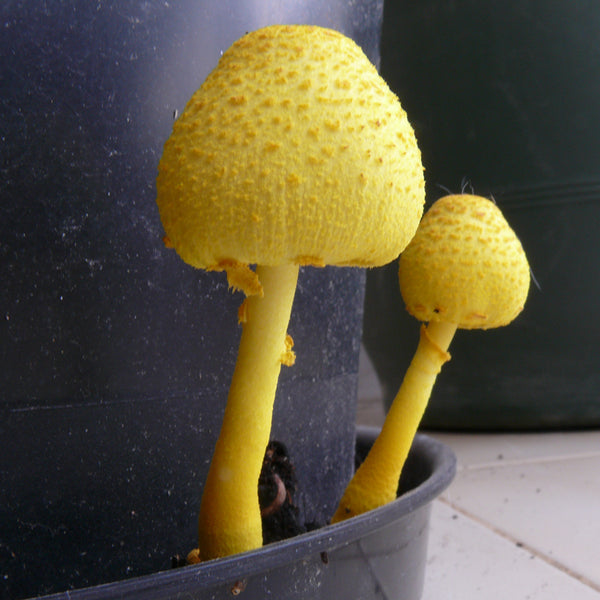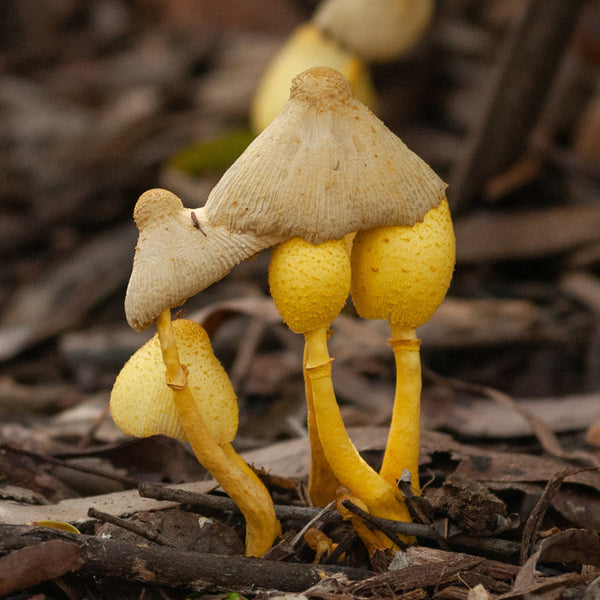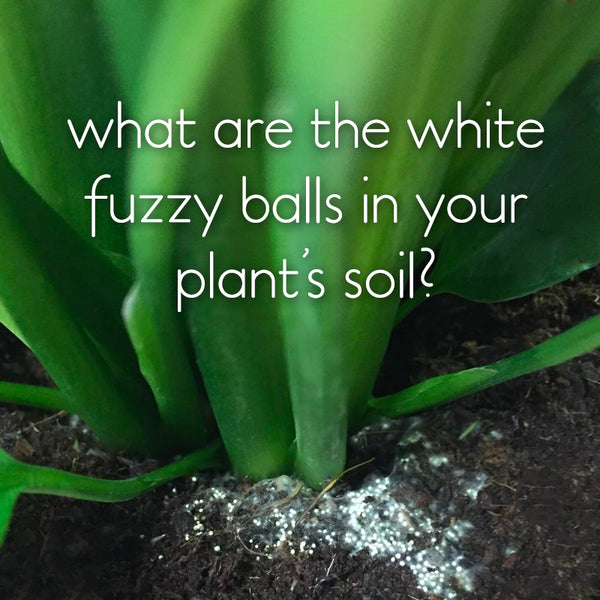The first time I noticed yellow mushrooms growing in one of my indoor plants I admit mum-mode kicked in. I was more worried about whether they might harm my son or my cats, rather than whether they'd harm my plants. Turns out I should have been worried about all 3, but not for the reasons you might think...

Image by Arria Belli
What type of mushroom are they?
Their botanical name is Leucocoprinus birnbaumii but they also used to be known as Lepiota lutea (I prefer the old name, it sounds like a Harry Potter spell). There are other yellow mushrooms but this variety are so often found in indoor plants that they are also known as ‘the yellow houseplant mushroom’.
Usually small and a cheery lemon yellow colour that fades as they age. Typically 3cm to 8cms tall with caps that start off bell-shaped and can open up to oval-shaped, which is what gives them their other common name of the yellow parasol, or flower pot parasol.
The cap surface is smooth but dotted with fine scales. It's a tropical species that has been introduced into New Zealand which you'll normally find outdoors in summer only, but they can pop up indoors and in greenhouses any time of year.
The caps change shape and colour over time, starting off brighter yellow with bell-shaped caps, fading to pale yellow then brown and opening up to wider parasol-shaped caps. Image by Rolf Lawrenz (rlawrenz)
Does the yellow houseplant mushroom harm indoor plants?
The good news is just having yellow houseplant mushrooms pop up in your indoor plants isn’t panic stations. They won’t hurt your houseplants, or you (unless you eat them!). But they are a sign something else may be wrong - and that IS something that can kill indoor plants. Plus you do want to keep them away from kids and pets.
Although there are such a thing as parasitic mushrooms, these are not that type. Leucocoprinus birnbaumii are a saprotrophic mushroom. Saprotrophs are fungi that are saprophytic, meaning they feed on dead organic matter for their food. They leave healthy matter alone, so won't damage your plant's roots. They also break down organic matter into nutrients plants can use.
Are yellow mushrooms in houseplants toxic?
The yellow houseplant mushroom is NOT edible and they may be toxic, so if you have curious kids or furry friends, you will want to get rid of them. The mushrooms that is, not the kids. As to how bad the mushrooms are if eaten, the jury's out. Some sources say their toxicity is unknown and possibly non-toxic, others say they will cause an upset stomach or possibly worse. But since the effects are unpredictable, it’s best not to find out!
How can you get rid of mushrooms in houseplants?
If you want them gone immediately, the good news is you can just remove them at the base of the stalk. However the bad news is entirely removing them is difficult without completely repotting, including washing all soil off the roots. Their spores like to travel and they can stay dormant for ages, waiting for the right conditions to sprout again.
The reality is they could be in your new potting mix already. Plus they do a great job at taking over the neighbourhood, so even if there are no signs of them in nearby plants (yet), given the right conditions they might pop up next door.
You could also treat your plant's substrate with a fungicide like Copper but these guys are pretty resilient, and really not that harmful, so unless there's another reason you want them gone, the easiest solution is to simply create conditions more favourable for your plants, and less favourable for your little yellow fungi friends and they will die or stay dormant.
It amazes me how fast these little chaps appear when conditions are just right, with small mushrooms growing in as little as one day, but then they're gone just as quickly when conditions change. Simply shifting your plant to a spot with more light and better airflow will help the substrate dry out faster, and sometimes within hours, no more mushrooms!
When should you be worried?
As far your plant’s concerned, yellow houseplant mushrooms won’t cause any harm, so if you like them, leave them be :) BUT what you might need to worry about is why they grew in the first place.
The yellow houseplant mushroom loves things dark, warm and wet, especially if there's organic matter rotting in your soil. For most houseplants that’s a dangerous combo. Soil that stays wet long enough for mushrooms to grow is a sign root rot could be next. Plus soil high in organic matter is often finer, more compact and has higher water retention. Great for outdoor gardens to hold on to precious water to stop roots drying out too fast. But indoors that can be bad news.
Having mushrooms pop up can also be a sign something that shouldn't be, is rotting, such as your plant's roots. That's not to say they have caused it, but could in fact be helping out by feeding on that rotted organic matter, turning it into nutrients. You can also accidentally end up growing mushrooms when you mix outdoor soil with your indoor plant substrate, or end up with spores if you shift your indoor plants outside for watering.
Most of our favourite indoor plants prefer chunky, airy, free-draining soil with low to medium water retention. In fact most prefer a substrate with no soil. Instead you'll often find ingredients like bark, pumice and fern fibre being used, not soil. There are exceptions of course, like moisture-loving Peace Lilies. Also the reason why Peace Lilies are one of the most common plants to find yellow houseplant mushrooms growing!
But if the plant is safely out of reach of curious hands (and paws), and your plant is happy in the same conditions the mushrooms prefer, then why not embrace your new yellow friends!
Keep learning
Speaking of fungi, those white or yellow fuzzy balls are NOT eggs. Here's what they are and what to do



